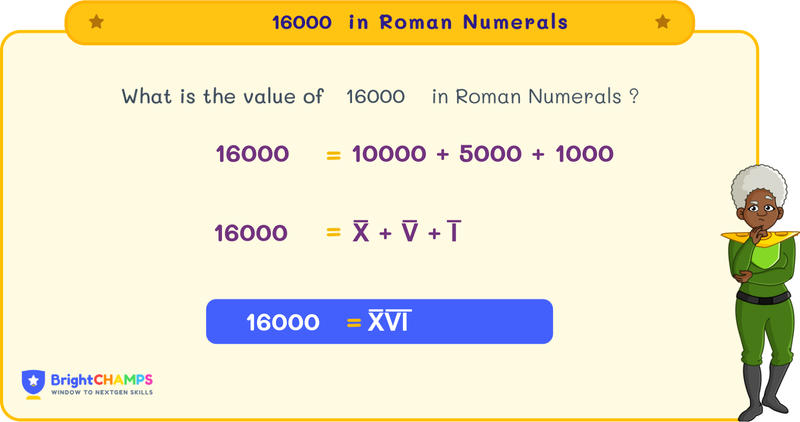Summarize this article:
 351 Learners
351 LearnersLast updated on August 5, 2025
16000 in Roman Numerals

Roman numerals are a way of expressing numbers using symbols. I, V, X, L, C, D, and M are the symbols we use. Roman Numerals are used in royal titles, book names, sequences, and more. Here we will be discussing Roman Numerals, rules, and examples.

What is 16000 in Roman Numerals?
In the context of royal titles, such as Henry I, Henry II, and so on, have you noticed the names and wondered what these symbols (I and II) represented?
Those are Roman Numerals. In ancient times, people used to count using fingers, sticks, bones, etc. As life became more complex, a standardized form was required to count. Ancient Romans used the Roman Numeral system to count. I (1), V (5), X (10), L (50), C (100), D (500), and M (1000) are the symbols we use to count.
In Roman Numerals, we use XVI to represent 16000, here X is 10000, V is 5000, and I is 1000. Let’s learn more about Roman numerals and how we write them.


Basic Rules for 16000 in Roman Numerals
There are certain basic rules to write a number in Roman Numerals. In this section, let’s discuss some basic rules that need to be remembered when writing a number in Roman numerals.
Rule 1: Addition Method
The addition method is used when the smaller number is placed after the larger number. For example, XVI → X + V + I → 10000 + 5000 + 1000 = 16000
Rule 2: Repetition Method
There are certain Roman Numerals that can be repeated up to three times. For instance, III → 3.
Rule 3: Subtraction Method
If a smaller number is followed by a larger number in Roman Numerals, we subtract the smaller number from the larger number. For example, IX → X - I → 10 - 1 = 9
Rule 4: Limitation Rule
The symbols cannot be repeated more than three times, and some symbols like V, L, and D cannot be repeated. For example, we won't write VV for 10; instead, we use X.

How to Write 16000 in Roman Numerals
Let’s now learn how to write 16000 in Roman Numerals. Follow these methods to write the number in Roman Numerals.
- By Expansion Method
- By Grouping Method
Explore Our Programs



16000 in Roman Numeral by Expansion Method
In the expansion method, based on the place value, the number is broken down. In this section, we will learn how to write 16000 in Roman numerals using the expansion method.
To write 16000 in Roman Numerals, follow the steps:
Step 1: Break the number based on the place value. Place value that is thousands, hundreds, etc. For 16000, we write it as 10000 + 5000 + 1000
Step 2: Converting the number into Roman Numerals
10000 in Roman Numeral — X
5000 in Roman Numeral — V
1000 in Roman Numeral — I
Step 3: Combining them Roman Numerals together.
Therefore, 16000 in Roman Numeral is X (10000) + V (5000) + I (1000) = XVI

16000 in Roman Numeral by Grouping Method
When writing a large number into Roman Numerals, we group the number.
To write 16000 in Roman Numeral, we group 16000 as 10000 + 5000 + 1000
10000 in Roman Numeral — X
5000 in Roman Numeral — V
1000 in Roman Numeral — I
So, 16000 is written as XVI in Roman Numerals.

Common Mistakes and How to Avoid Them in 16000 Roman Numerals
Students make mistakes when writing a number in Roman Numerals. To master Roman Numerals, we can learn a few common mistakes and the ways to avoid them.

16000 in Roman Numerals Examples

Problem 1
A historian discovers an ancient manuscript that mentions a treasure buried for XVI centuries. How many years is this in total?

The total number of years is 16000.
Explanation
XVI centuries means 16 centuries.
Each century is 100 years, so 16 × 100 = 1600 years.
However, it seems there is a confusion here as the question is meant to relate to the number 16000 in Roman numerals.
The manuscript actually refers to a span of 16000 years, which is simply 16000.

Problem 2
An archaeologist finds a scroll dated to the year MMMMMMMMMMMMMMMM (16 times M). What is this year in the common era?

The year in the common era is 16000.
Explanation
Each M represents 1000 in Roman numerals.
Therefore, MMMMMMMMMMMMMMMM is 16 times M, which equals 16 × 1000 = 16000.

Problem 3
A large amphitheater is said to have a seating capacity of XVI thousands in a Roman numeral inscription. How is this capacity represented in Roman numerals?

The seating capacity is represented as XVI̅.
Explanation
XVI represents 16. In Roman numerals, a bar over a numeral multiplies its value by 1000.
Therefore, XVI with a bar over it represents 16000.

Problem 4
A merchant has a collection of artifacts valued at MMMMMMMMMMMMMMMM sesterces. Convert this value into Arabic numerals.

The value is 16000 sesterces.
Explanation
Each M in Roman numerals stands for 1000.
MMMMMMMMMMMMMMMM, with 16 Ms, equals 16 × 1000 = 16000.

Problem 5
Calculate the difference in value between two ancient estates, one valued at XX thousand sesterces and another at XVI thousand sesterces. How much more is the first estate worth in Roman numerals?

The first estate is worth IV thousand more, which is represented as IV̅.
Explanation
XX thousand represents 20000 and XVI thousand represents 16000.
The difference is 20000 - 16000 = 4000.
In Roman numerals, 4000 is represented as IV̅ (IV with a bar over it).


FAQs on 16000 in Roman Numerals
1.What is 9000 in Roman numerals?
2.How to write 16000 in Roman numerals?
3.What is 160 in Roman Numerals?
4.Is XVI a prime number?
5.What are the multiples of 16000?

Important Glossaries for 16000 in Roman Numerals
- Addition rule: The addition method is used when a large number is followed by a smaller numeral; here, the values are added. For example, XVI = X + V + I = 10000 + 5000 + 1000 = 16000
- Grouping method: Here, the given number is grouped based on its place value, and then each group is converted into its Roman numerals. For example, 16000 = 10000 + 5000 + 1000 = XVI
- Repetition rule: Certain symbols (I, X, C, M) in the Roman numeric system can be repeated only up to three times. For example, III = 3 (I is repeated three times to represent the number 3).
- Subtraction rule: When a smaller numeral precedes a larger numeral, it is subtracted. For example, IX = X - I = 10 - 1 = 9
- Overline rule: Placing a line over a numeral multiplies its value by 1,000. For example, V̅ represents 5000.



Hiralee Lalitkumar Makwana
About the Author
Hiralee Lalitkumar Makwana has almost two years of teaching experience. She is a number ninja as she loves numbers. Her interest in numbers can be seen in the way she cracks math puzzles and hidden patterns.
Fun Fact
: She loves to read number jokes and games.

















